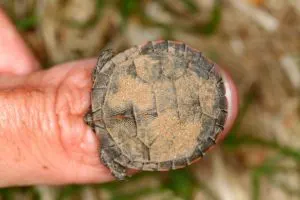There is only one true way to tell a turtle’s age and that is to know its hatch date. The methods below are all just tools to help you estimate your turtles’ age if you don’t know their hatch date.
One of the things turtles are well-known for is their long lifespans. Many tortoises have lifespans of over 150 years.
This longevity is one reason why determining the exact age of a turtle can be crucial for proper care and conservation efforts. For instance, the giant tortoise, which exhibits negligible senescence, meaning their risk of death does not increase as they age, can be one of the longest-living animals on Earth, rivaling even human years in longevity.
An example is the giant Galapagos tortoises, with Chelonoidis nigra nigra having an average lifespan of 177 years.
Sea turtles also have long lifespans, the green turtle is believed to have a lifespan of 80 years. Of course, it’s much more difficult to track the age of sea turtles as they live in oceans.
Even with captive land tortoises and freshwater turtles, it is still a bit of a challenge as these long-lived animals change hands several times within their lifetime.
How can you tell how old a turtle is? The best way to estimate the age of your turtle is through a combination of methods, as there is no accurate method to determine the exact age once the hatch date is unknown.
Table of Contents
How To Tell A Turtle’s Age
Before we discuss the most popular pet turtles and how to estimate their age, it is important to note that these methods provide an educated guess rather than a definitive number of years of age.
1. Check the rigidity of the shell
If the turtle in question isn’t a softshell turtle, then checking the rigidity of the shell can allow you to estimate if it’s under 6 months old or over.
It’s safe to assume that a small tortoise with a soft shell is under half a year old. The softer the shell, the younger the chelonian typically is. The turtle’s shell takes time to harden – normally between 6 to 8 months.
Do not press the shell, just touch it gently. The shell is part of the bone structure of the chelonian, you don’t want to damage the shell or harm the turtle as its internal organs are housed inside the shell.
Of course, a soft shell can be due to nutritional metabolic bone disease also known as nutritional secondary hyperparathyroidism (NSHP).
Also, softshell turtles have soft shells. Of course, this type of shell feels different to touch. A Softshell turtle’s soft shell feels leathery as it is tough skin that spreads over the turtle’s back and forms the carapace. A baby turtle’s shell on the other hand feels spongy to touch.
2. Measure the length of the shell and the weight

Using a size chart can be a good way to approximate the age based on the length of the turtle, especially in species where the maximum size is known. Younger turtles will naturally be smaller, and comparing them to an average size chart for their species can give you an insight into how much time they may need to reach full size.
Turtles generally reach their average maximum length at maturity. They may continue to increase in length after that but it’ll be at a very slow rate.
If you know the species of your turtle or tortoise, then you can measure the straight carapace length, this can tell you whether or not the turtle is sexually mature. You can then use this to estimate the turtle’s age.
Different species normally reach maturity at different ages. For instance, red-eared sliders generally reach sexual maturity when they are 5 to 6 years old and have attained a carapace length of about 10 cm for males and 15 cm for females.
Therefore to use this test you will also need to determine the gender of your turtle as well.
This isn’t 100% accurate as turtles that eat more grow quicker than turtles that eat less. But measuring the straight carapace length can give you a rough estimate of whether your turtle has or hasn’t reached sexual maturity.
This is usually around 5-6 years for most small to medium-sized freshwater turtles. Also, female turtles generally grow faster/larger than male turtles, so consider that.
3. Count the rings of a scute

Counting the growth rings on the scutes, the bony plates that make up the upper shell, is the most common method used to estimate turtle age. In species like wood turtles and green sea turtles, these rings can be akin to tree rings, potentially reflecting the annual cycle of growth during an individual turtle’s life.
The size of the turtle can give you a rough estimate of the chelonian’s age. The carapace length only reveals whether or not the turtle is an adult (sexually mature).
If you want to know more about the turtle’s age, you can count the rings on the turtle’s scute. The scutes are the plates that made up the turtle’s carapace (shell). These give an extremely rough estimate as it denotes periods of growth.
A ring indicates a growth spurt even if that growth signifies just a very little time. This is to say it shows periods of famine when the turtle had little to eat and periods of bountifulness when the turtle had a lot to eat.
Level of growth is directly determined by how much the chelonian has to eat.
The rings generally alternate between wide rings of one color and tinier rings of another color. The wider rings show periods of bountiful when there is a lot to eat while narrower rings show periods of scarcity.
Of course with wild turtles, the narrow rings generally correspond with winter (cold months), and the wide rings correspond with the warm months such as spring and summer.
To estimate the age of the turtle, divide the number of rings by two. For instance, if a turtle has 16 rings on the scutes, you can estimate that this turtle is 8 years old.
4. Check the sexual maturity of the turtle

Observing the sexual maturity can give you a rough estimation of whether your turtle is a young adult or fully grown turtle. In many types of turtles, including most pet species and wild turtles like the adult eastern box turtles found in the Rocky Mountains, sexual maturity correlates with a certain range of age.
As explained earlier, turtles generally reach sexual maturity at a particular age. While this is not 100% accurate as most turtle breeders prefer to use size (in particular length) as a determinant of sexual maturity.
A sexually mature female turtle will be gravid and lay eggs even without mating. If your female turtle lays eggs then you can safely assume that she is mature. Depending on the species, you can estimate her minimum age.
5. Skeletochronology testing
This is usually done on wild turtles at the time of death. This is used especially to determine the age and growth rates of sea turtles such as loggerhead sea turtles (Caretta caretta) in the Mediterranean Sea.
The humerus, scapula, ilium, and femur bones are the ones usually studied here. Skeletochronology refers to counting LAGs (lines of arrested annual growth) of skeletal tissues to determine the age and growth rate of a vertebrate, in this case, turtles.
Skeletochronology is a much more accurate way to determine the age of a turtle than counting rings. However, the downside to this is that it can only be performed on dead turtles.
This testing is useful to marine zoologists and other zoologists who want to study sea turtles and other turtle species.
6. Visual inspection

Additionally, marine biologists often look for visual signs of aging in sea turtles as part of conservation efforts. The age of a sea turtle can influence reproductive patterns, which are vital for these efforts.
Visual cues can tell you a lot about the turtle’s age. Older turtles will move more slowly or eat less. They may also be more herbivorous. Also, you can notice wear and tear on the turtle.
An older turtle’s shell can be quite worn out with dents and scratches. Turtles with very smooth shells are very old – usually almost 100 years old or older.
The older a turtle gets, the smoother its shell gets as it is exposed to erosion from sand and rainfall. The rings, ridges, and bumps smooth out. This is especially true of tortoises.
7. Keep track of the turtle’s hatch date

For turtle owners, keeping a record of your pet’s age is a practice akin to tracking a pet’s lineage. Knowing your turtle’s hatch date can also help when using growth charts or consulting with experts like Beth Reinke or David Miller, who have studied the life expectancy and growth patterns in turtles.
This is the only way to tell a turtle’s age with all certainty. Knowing the month within which the turtle hatches can allow you to accurately tell the age of the turtle.
Although all the other ways might allow you to estimate the age of the turtle, the actual age might never be known. Keeping track of a turtle’s hatch date isn’t as easy as you may think.
Many turtles live long and change hands several times. The true age of the turtle can easily become lost over time. It is important to document your turtle’s age and keep all pet vet records handy just in case it needs to change hands.
Conclusion
While we may never know the turtle years as precisely as we do with human years, understanding how to tell the age of a snapping turtle or any species of turtle contributes to their proper diet and care for a long time. Whether for a pet or in a natural habitat, appreciating the life cycle of these creatures is essential for any turtle enthusiast.
There are many reasons why you may need or want to know your turtle’s age. Age helps you determine their diet, breeding capabilities, and even the anticipated adult size of the turtle.
Of course, the only way to know a turtle’s age with 100% certainty is to know the turtle’s hatch date. The younger the turtle, the easier it is to tell the age.
Some techniques already mentioned include counting the rings of the scutes (depending on the species), checking the size of the turtle (if you know the species), and checking the sexual maturity of the turtle.
If you have any other tips or tricks to help determine a turtle’s age, please leave a comment below.

Sabrina
Sunday 14th of August 2022
For some amateur owners, we're focused on keeping our turtles healthy and don't know the difference between a scute and a scooter. Pictures or diagrams would have been extremely helpful. Now we need to search elsewhere for visuals.